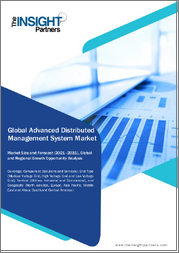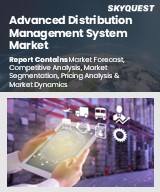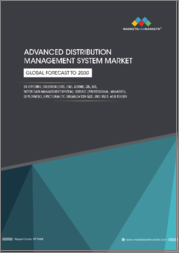
|
시장보고서
상품코드
1611001
세계의 FPI(Fault Passage Indicators) 시장(2024-2031년)Global Fault Passage Indicators Market 2024-2031 |
||||||
FPI(Fault Passage Indicators) 시장 규모, 점유율, 동향 분석 보고서 : 제품 유형별(가공선 FPI, 지중 FPI, 패널 FPI, 기타), 전압 레벨별(저전압(LV) FPI, 중전압(MV) FPI, 고압(HV) FPI), 최종사용자별(유틸리티, 산업, 주거용) 전압(HV) FPI), 최종사용자별(유틸리티, 산업용, 상업용, 주거용) : 예측 기간(2024-2031년)
FPI(Fault Passage Indicators) 시장은 예측 기간(2024-2031년) 동안 연평균 12.4%의 높은 성장률을 기록할 것으로 예상됩니다. 시장 성장의 배경에는 전력망의 신속한 대응 및 복구에 대한 수요 증가, 전력망 현대화 및 에너지 효율화에 대한 규제 강화, 정전 및 시스템 다운타임 감소에 대한 관심 증가, 전력회사의 유지보수 비용 절감에 대한 인식 증가 등 매우 중요한 요인들이 있습니다. 국제에너지기구(IEA)에 따르면, 2024년 7월 세계 전력 수요는 2023년 2.5%에서 2024년 4.0% 증가할 것으로 예상됩니다.
시장 역학
스마트 그리드 기술과의 통합 증가
FPI(Fault Passage Indicators) 시장의 성장은 스마트 그리드 기술과의 통합을 통해 이루어질 것입니다. 스마트 그리드 기술은 전력회사가 실시간으로 고장을 감지하고 격리하는 능력을 강화하여 배전 시스템의 신뢰성과 효율성을 향상시킵니다. 스마트 그리드는 고도의 통신과 자동화를 촉진하고 정전 시 신속한 의사결정을 돕는 중요한 데이터를 FPI에 제공할 수 있습니다. 또한, 스마트 그리드 인프라의 도입은 예지보전 전략을 지원하여 다운타임과 운영비용을 절감할 수 있습니다. 전력회사들이 그리드 복원력을 강화하기 위해 디지털 솔루션을 채택하는 경향이 높아짐에 따라 FPI에 대한 수요도 증가할 것으로 예상됩니다. FPI와 스마트 그리드 기술의 통합은 전기 네트워크 현대화에 있어 매우 중요한 진전이며, 에너지 효율과 지속가능성을 촉진하는 규제 노력은 시장 성장을 더욱 촉진할 것입니다.
강화된 통신 기능의 채택 확대
FPI(Fault Passage Indicators) 시장은 통신 기능 강화의 영향을 받고 있습니다. 고급 표시기는 배전 네트워크 내 고장 지점을 실시간으로 모니터링하고 신속하게 식별할 수 있도록 도와줍니다. FPI는 최신 통신 기술을 활용하여 유틸리티 회사에 즉각적인 데이터 전송을 제공함으로써 응답 시간을 단축하고 정전 시간을 줄일 수 있습니다. 사물인터넷(IoT) 솔루션의 통합은 이러한 기능을 더욱 강화하여 원활한 연결과 데이터 분석을 가능하게 합니다. 유틸리티 기업들이 점점 더 신뢰성과 운영 효율성을 우선시함에 따라 FPI에 대한 수요는 증가할 것으로 예상됩니다.
시장 세분화
- 시장 세분화는 제품 유형별로 가공선 FPI, 지중 FPI, 패널 FPI, 기타(특수 또는 하이브리드 FPI)로 나뉩니다.
- 전압 레벨에 따라 시장은 저전압(LV) FPI, 중전압(MV) FPI, 고전압(HV) FPI로 나뉩니다.
- 최종사용자별로 유틸리티, 산업용, 상업용, 주거용으로 구분됩니다.
가선용 FPI가 가장 큰 시장 점유율을 차지할 것으로 전망
고압선로용 FPI는 고장 감지 속도를 높이고 정전 시간을 단축하는 등 성장의 주요 요인으로 작용하고 있습니다. 전력망 인프라가 노후화되고 안정적인 배전에 대한 수요가 증가함에 따라 전력회사들은 전력망의 내결함성을 강화하기 위해 이러한 지표의 채택을 늘리고 있습니다. 원격 모니터링 및 무선 통신과 같은 기술 발전은 시장 성장을 더욱 촉진하고 있습니다. 또한, 송전망의 현대화를 촉진하는 규제 의무화도 가공 송전선로 FPI의 채택 확대에 기여하고 있습니다. FPI(Fault Passage Indicators)는 고장 전류 표시기를 통해 고장을 신속하게 식별하고 분리하여 서비스 중단을 최소화하고 유지보수 작업을 최적화함으로써 고전압 가공 및 지중 네트워크의 신뢰성을 향상시킵니다. 예를 들어, CAHORS 그룹은 가공 및 지중 FPI(FPI/FCI)를 제공합니다. 이 표시기는 영구 고장 및 발생한 모든 이벤트의 수에 대한 정보를 제공하여 고장난 네트워크 섹션을 신속하게 식별할 수 있도록 합니다. 이 회사는 중전압 가공 및 지중 네트워크에 방향성, 암페로메트릭 또는 FPI(또는 고장 전력 표시기)를 제공합니다.
상당한 시장 점유율을 차지하고 있는 유틸리티
이 분야의 성장을 뒷받침하는 요인으로 신뢰할 수 있고 효율적인 배전에 대한 수요 증가를 꼽을 수 있습니다. 전력회사들은 시스템의 신뢰성을 높이고 정전 시간을 최소화하기 위해 첨단 모니터링 기술에 투자하고 있습니다. FPI는 전기 네트워크의 고장을 신속하게 식별하여 신속한 대응과 유지보수를 가능하게 합니다. 스마트 그리드 기술의 통합은 FPI의 채택을 촉진하고 있으며, 이러한 장치는 운영 효율성 향상과 다운타임 감소에 기여하고 있습니다. 또한, 전력망 복원력 강화를 위한 규제 의무화로 인해 전력회사들은 이러한 혁신적인 솔루션을 더욱 적극적으로 도입하고 있습니다. 예를 들어, Tesmec S.p.A.는 실외용 방향성 FPI(RGDAT A-70)와 고성능, 저비용, 간편한 설치가 가능한 새로운 통합 디지털 모니터링 및 보호 장치를 제공합니다. 중성점 유지보수가 필요한 8kV에서 36kV까지의 모든 MV 시스템에 적합합니다.
지역별 전망
FPI(Fault Passage Indicators) 세계 시장은 북미(미국, 캐나다), 유럽(영국, 이탈리아, 스페인, 독일, 프랑스, 기타 유럽), 아시아태평양(인도, 중국, 일본, 한국, 기타 아시아태평양), 기타 지역(중동 및 아프리카, 라틴아메리카)으로 나뉩니다.
북미에서 고장통과 표시기 채택 확대
이 지역의 성장은 전력 인프라의 노후화로 인해 전력회사가 첨단 모니터링 기술에 투자하도록 유도하고 있기 때문입니다. 스마트 그리드 기술 통합에 대한 수요 증가가 이 지역의 FPI 시장을 주도하고 있습니다. 미국 전역의 전력망 복원력과 신뢰성을 강화하기 위한 정부 투자는 FPI와 같은 첨단 기술의 채택을 촉진하여 전력망 모니터링 및 고장 감지 효율을 향상시키고 있습니다. 예를 들어, 미국 에너지부는 2023년 10월 미국 전역의 전력망 복원력과 신뢰성을 강화하기 위해 44개 주에 걸쳐 58개 프로젝트에 34억 6,000만 달러를 투자할 것이라고 발표했습니다. 이 프로젝트는 새로운 변속기뿐만 아니라 배터리 저장, 로컬 마이크로그리드, 그리드 신뢰성에 대한 투자를 통해 종합적인 스마트 그리드 인프라를 업데이트할 예정입니다.
유럽이 큰 시장 점유율을 차지
유럽은 ABB, 제너럴 일렉트릭, 슈나이더 일렉트릭 SE, 지멘스 AG와 같은 FPI 공급업체가 존재하여 큰 점유율을 차지하고 있습니다. 시장 성장의 배경에는 송전망 신뢰성에 대한 중요성 증가, 스마트 그리드 기술에 대한 투자, 규제 지원, 안전 기준 강화, 센서 기술 및 데이터 분석의 혁신을 통한 성능 향상 등이 있습니다. 유럽투자은행(EIB)에 따르면, 2024년 9월 유럽투자은행(EIB)은 슬로베니아 전력회사 Elektro Ljubljana에 5,000만 유로(5,430만 달러)를 대출하여 슬로베니아 중부 및 남동부 지역의 배전망을 확장 및 개선할 예정이라고 밝혔습니다. 시장 업체들은 배전망의 신뢰성을 높이기 위해 단락, 지락, 위상 불연속을 감지하고 고장을 신속하게 식별하고 구분할 수 있는 FPI(Fault Passage Indicators)를 제공하고 있습니다. 예를 들어, ABB는 단락, 지락, 위상 불연속을 감지하기 위해 단로단자장치(DTU)와 함께 사용할 수 있는 FPI SPEF 3A2 C 타입을 제공하고 있습니다.
FPI(Fault Passage Indicators) 시장에 진출한 주요 기업으로는 ABB Ltd., Eaton Corp., General Electric Co.(GE Grid Solutions), Schneider Electric, Siemens AG 등이 있습니다. 시장 경쟁력을 유지하기 위해 각 업체들은 제휴, 합병, 인수 등의 전략을 적용하고 사업 확장 및 제품 개발에 점점 더 많은 노력을 기울이고 있습니다.
최근 동향
- 2024년 12월, DISTRIBUTECH는 지하 배전망에 사용되는 FPI를 발표했습니다. 지하 배전망에 고급 FPI(Fault Passage Indicators)를 통합하면 계획되지 않은 고장 이벤트가 시스템 평균 무정전 기간 지수(SAIDI) 및 관련 지수에 미치는 영향을 줄일 수 있습니다.
목차
제1장 보고서 개요
- 업계 현황 분석과 성장 가능성 전망
- 분석 방법과 툴
- 시장 내역
- 부문별
- 지역별
제2장 시장 개요와 인사이트
- 분석 범위
- 애널리스트의 분석과 현재 시장 동향
- 주요 업계 동향
- 추천사항
- 결론
제3장 경쟁 구도
- 주요 기업 분석
- 개요
- 재무 분석
- SWOT 분석
- 최근의 동향
- 주요 전략 분석
제3장 경쟁 구도
- 주요 기업 분석
- ABB Ltd.
- 개요
- 재무 분석
- SWOT 분석
- 최근의 동향
- Eaton Corp.
- 기업 개요
- 재무 분석
- SWOT 분석
- 최근의 동향
- General Electric Co.
- 개요
- 재무 분석
- SWOT 분석
- 최근의 동향
- Schneider Electric SE
- 개요
- 재무 분석
- SWOT 분석
- 최근의 동향
- Siemens AG
- 개요
- 재무 분석
- SWOT 분석
- 최근의 동향
- 주요 전략 분석
제4장 시장 세분화
- 세계의 FPI(Fault Passage Indicators) 시장 : 제품 종류별
- 세계의 FPI(Fault Passage Indicators) 시장 : 전압 레벨별
- 세계의 FPI(Fault Passage Indicators) 시장 : 최종사용자별
- 제품 유형별 FPI(Fault Passage Indicators) 세계 시장
- 가공선 FPI
- 지하 FPI
- 패널 FPI
- 기타(특수형 또는 하이브리드형 FPI)
- 전압 레벨별 FPI(Fault Passage Indicators) 세계 시장
- 저전압(LV) FPI
- 중전압(MV) FPI
- 고전압(HV) FPI
- FPI(Fault Passage Indicators) 세계 시장 : 최종사용자별
- 유틸리티
- 산업용
- 상업용
- 가정용
제5장 지역별 분석
- 북미
- 미국
- 캐나다
- 유럽
- 영국
- 독일
- 이탈리아
- 스페인
- 프랑스
- 기타 유럽
- 아시아태평양
- 중국
- 인도
- 일본
- 한국
- 기타 아시아태평양
- 세계 기타 지역
- 라틴아메리카
- 중동 및 아프리카
제6장 기업 개요
- ATRIY ELECTRONIC APPLIANCES TRADING LLC.
- C&S Electric Ltd.
- CAHORS Group
- EFACEC Power Solutions
- Elektro-Mechanik EM GmbH
- ELVAC a.s.
- Ensto Oy
- Float Power Systems & Controls
- Horstmann GmbH
- HV Power Measurements and Protection Ltd.
- Kries-Energietechnik GmbH & Co. KG
- NARI Group Corp.
- ROMIND
- Schweitzer Engineering Laboratories, Inc.
- Southern States, LLC
- Streamer Inc.
- Tesmec S.p.A.
- Texas Instruments Inc.
- TransNet NZ Ltd.
- Xiamen Andaxing Electric Group Co., Ltd.
- ZIV Aplicaciones y Tecnologia, S.L.U
Fault Passage Indicators Market Size, Share & Trends Analysis Report by Product Type (Overhead Line Fault Passage Indicators, Underground Fault Passage Indicators, Panel Fault Passage Indicators, and Others), Voltage Level (Low Voltage (LV) Fault Passage Indicators, Medium Voltage (MV) Fault Passage Indicators and High Voltage (HV) Fault Passage Indicators), and by End-User (Utilities, Industrial, Commercial and Residential) Forecast Period (2024-2031)
Fault passage indicators (FPIs) market is anticipated to grow at a significant CAGR of 12.4% during the forecast period (2024-2031). The market growth is attributed to pivotal factors such as increasing demand for quick response and restoration of power networks, regulatory push for grid modernization and energy efficiency, growing focus on reducing power outages and system downtime, and rising awareness about reducing maintenance costs for utilities. According to the International Energy Agency, in July 2024, Global electricity demand is forecast to grow by around 4.0% in 2024, up from 2.5% in 2023
Market Dynamics
Increasing Integration with Smart Grid Technologies
The growth of the fault passage indicators (FPI) market is driven by their integration with smart grid technologies. Smart grid technologies enhance the ability of utility companies to detect and isolate faults in real-time, thereby improving the reliability and efficiency of power distribution systems. Smart grids facilitate advanced communication and automation, enabling FPIs to provide critical data that aids in swift decision-making during outages. Additionally, the deployment of smart grid infrastructure supports predictive maintenance strategies, reducing downtime and operational costs. As utilities increasingly adopt digital solutions to enhance grid resilience, the demand for FPIs is expected to rise. The regulatory initiatives promoting energy efficiency and sustainability further bolster market growth. The integration of FPIs with smart grid technologies represents a pivotal advancement in modernizing electrical networks.
Growing Adoption of Enhanced Communication Capabilities
The fault passage indicators (FPI) market is influenced by enhanced communication capabilities. The advanced indicators facilitate real-time monitoring and swift identification of fault locations within electrical distribution networks. By leveraging modern communication technologies, FPIs provide utilities with immediate data transmission, allowing for faster response times and reduced outage durations. The integration of Internet of Things (IoT) solutions further enhances these capabilities, enabling seamless connectivity and data analysis. As utilities increasingly prioritize reliability and operational efficiency, the demand for FPIs is expected to rise.
Market Segmentation
- Based on the product type, the market is segmented into overhead line fault passage indicators, underground fault passage indicators, panel fault passage indicators, and others (specialized or hybrid fault passage indicators).
- Based on the voltage level, the market is segmented into low voltage (LV) fault passage indicators, medium voltage (MV) fault passage indicators, and high voltage (HV) fault passage indicators.
- Based on the end-user, the market is segmented into utilities, industrial, commercial, and residential.
Overhead Line Fault Passage Indicators Segment is Projected to Hold the Largest Market Share
The primary factors supporting the growth include the overhead line fault passage indicators enabling quicker fault detection and reducing outage times. With the increasing aging grid infrastructure and the growing demand for reliable power distribution, utilities are increasingly adopting these indicators to enhance grid resilience. Technological advancements, including remote monitoring and wireless communication, further bolster market growth. Additionally, regulatory mandates promoting grid modernization contribute to the rising adoption of overhead line FPIs. Fault Passage Indicators (FPIs) enhance the reliability of medium voltage overhead and underground networks by utilizing fault current indicators to quickly identify and isolate faults, minimizing service interruptions and optimizing maintenance efforts. For instance, CAHORS Group offers overhead and underground fault passage indicators (FPI / FCI). The fault passage indicators quickly identify faulty network sections by providing information about permanent faults and a count of all events that have occurred. The company offers directional and Amperometric fault passage indicators or fault current indicators for medium voltage overhead and underground networks.
Utilities to Hold a Considerable Market Share
The factors supporting segment growth include the increasing demand for reliable and efficient power distribution, and utilities are investing in advanced monitoring technologies to enhance system reliability and minimize outage durations. Fault Passage Indicators provide quickly identifying faults within electrical networks, enabling rapid response and maintenance. The integration of smart grid technologies is propelling the adoption of FPIs, as these devices contribute to improved operational efficiency and reduced downtime. Additionally, regulatory mandates aimed at enhancing grid resilience further encourage utilities to implement such innovative solutions. For instance, Tesmec S.p.A. offers an outdoor directional fault passage indicator (RGDAT A-70), and the new integrated digital monitoring and protection device that provides high performance, low cost, and easy installation. It is suitable for all MV systems, from 8kV to 36 kV with any neutral maintenance.
Regional Outlook
The global fault passage indicators market is further segmented based on region including North America (the US, and Canada), Europe (the UK, Italy, Spain, Germany, France, and the Rest of Europe), Asia-Pacific (India, China, Japan, South Korea, and Rest of Asia-Pacific), and the Rest of the World (the Middle East & Africa, and Latin America).
Growing Adoption of Fault Passage Indicators in North America
The regional growth is attributed to aging electrical infrastructure prompting utilities to invest in advanced monitoring technologies, The increasing demand for smart grid technology integration is driving the FPIs market in the region, Additionally, innovations in FPI technology, such as wireless communication and IoT integration, are further fueling market growth. Government investments aimed at enhancing electric grid resilience and reliability across America are driving the adoption of advanced technologies such as fault passage indicators, improving grid monitoring and fault detection efficiency. For instance, in October 2023, the US Department of Energy announced $3.46 billion for 58 projects across 44 states to strengthen electric grid resilience and reliability across America. The project makes a comprehensive smart grid infrastructure update, through investments in battery storage, local microgrids, and grid reliability, as well as new transmission lines.
Europe Holds Major Market Share
Europe holds a significant share owing to the presence of fault passage indicators offering companies such as ABB Ltd., General Electric Co., Schneider Electric SE, Siemens AG, and others. The market growth is attributed to the increased focus on grid reliability, investment in smart grid technologies, regulatory support, enhanced safety standards, and innovations in sensor technology and data analytics are improving the performance to drive the growth of the market. According to the European Investment Bank (EIB), in September 2024, European Investment Bank (EIB) is lending Slovenian electricity company Elektro Ljubljana €50 million ($54.3 million) to expand and upgrade the power-distribution network in central and southeastern parts of the country. Market players offer fault passage indicators (FPIs) for the reliability of distribution networks by detecting short circuits, earth faults, and phase discontinuities, enabling quicker identification and isolation of faults. For instance, ABB Ltd. offers the fault indicator type SPEF 3A2 C is used in association with disconnect terminal units (DTUs) for the detection of short circuits, earth faults, and phase discontinuity in distribution networks.
The major companies serving the fault passage indicators market include ABB Ltd., Eaton Corp., General Electric Co. (GE Grid Solutions), Schneider Electric, and Siemens AG among others. The market players are increasingly focusing on business expansion and product development by applying strategies such as collaborations, mergers and acquisitions to stay competitive in the market.
Recent Development
- In December 2024, DISTRIBUTECH announced fault passage indicators used in underground distribution grids. The integration of advanced fault passage indicators (FPIs) into underground distribution networks reduces the impact of unplanned fault events on the system average interruption duration index (SAIDI) and related indices.
Table of Contents
1. Report Summary
- Current Industry Analysis and Growth Potential Outlook
- 1.1. Research Methods and Tools
- 1.2. Market Breakdown
- 1.2.1. By Segments
- 1.2.2. By Region
2. Market Overview and Insights
- 2.1. Scope of the Report
- 2.2. Analyst Insight & Current Market Trends
- 2.2.1. Key Market Trends
- 2.2.1.1. Advancements in Fault Detection and Monitoring
- 2.2.1.2. Automation and Digitization in Utilities
- 2.2.1.3. Investment in Smart Grids and Energy Infrastructure
- 2.2.2. Recommendations
- 2.2.3. Conclusion
- 2.2.1. Key Market Trends
3. Competitive Landscape
- 3.1. Key Company Analysis
- 3.2. ABB Ltd.
- 3.2.1. Overview
- 3.2.2. Financial Analysis
- 3.2.3. SWOT Analysis
- 3.2.4. Recent Developments
- 3.3. Eaton Corp.
- 3.3.1. Overview
- 3.3.2. Financial Analysis
- 3.3.3. SWOT Analysis
- 3.3.4. Recent Developments
- 3.4. General Electric Co.
- 3.4.1. Overview
- 3.4.2. Financial Analysis
- 3.4.3. SWOT Analysis
- 3.4.4. Recent Developments
- 3.5. Schneider Electric SE
- 3.5.1. Overview
- 3.5.2. Financial Analysis
- 3.5.3. SWOT Analysis
- 3.5.4. Recent Developments
- 3.6. Siemens AG
- 3.6.1. Overview
- 3.6.2. Financial Analysis
- 3.6.3. SWOT Analysis
- 3.6.4. Recent Developments
- 3.7. Key Strategy Analysis
4. Market Segmentation
- 4.1. Global Fault Passage Indicators Market by Product Type
- 4.1.1. Overhead Line Fault Passage Indicators
- 4.1.2. Underground Fault Passage Indicators
- 4.1.3. Panel Fault Passage Indicators
- 4.1.4. Others (Specialized or Hybrid Fault Passage Indicators)
- 4.2. Global Fault Passage Indicators Market by Voltage Level
- 4.2.1. Low Voltage (LV) Fault Passage Indicators
- 4.2.2. Medium Voltage (MV) Fault Passage Indicators
- 4.2.3. High Voltage (HV) Fault Passage Indicators
- 4.3. Global Fault Passage Indicators Market by End-User
- 4.3.1. Utilities
- 4.3.2. Industrial
- 4.3.3. Commercial
- 4.3.4. Residential
5. Regional Analysis
- 5.1. North America
- 5.1.1. United States
- 5.1.2. Canada
- 5.2. Europe
- 5.2.1. UK
- 5.2.2. Germany
- 5.2.3. Italy
- 5.2.4. Spain
- 5.2.5. France
- 5.2.6. Rest of Europe
- 5.3. Asia-Pacific
- 5.3.1. China
- 5.3.2. India
- 5.3.3. Japan
- 5.3.4. South Korea
- 5.3.5. Rest of Asia-Pacific
- 5.4. Rest of the World
- 5.4.1. Latin America
- 5.4.2. Middle East and Africa
6. Company Profiles
- 6.1. ATRIY ELECTRONIC APPLIANCES TRADING LLC.
- 6.2. C&S Electric Ltd.
- 6.3. CAHORS Group
- 6.4. EFACEC Power Solutions
- 6.5. Elektro-Mechanik EM GmbH
- 6.6. ELVAC a.s.
- 6.7. Ensto Oy
- 6.8. Float Power Systems & Controls
- 6.9. Horstmann GmbH
- 6.10. HV Power Measurements and Protection Ltd.
- 6.11. Kries-Energietechnik GmbH & Co. KG
- 6.12. NARI Group Corp.
- 6.13. ROMIND
- 6.14. Schweitzer Engineering Laboratories, Inc.
- 6.15. Southern States, LLC
- 6.16. Streamer Inc.
- 6.17. Tesmec S.p.A.
- 6.18. Texas Instruments Inc.
- 6.19. TransNet NZ Ltd.
- 6.20. Xiamen Andaxing Electric Group Co., Ltd.
- 6.21. ZIV Aplicaciones y Tecnologia, S.L.U



















